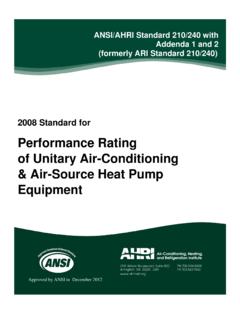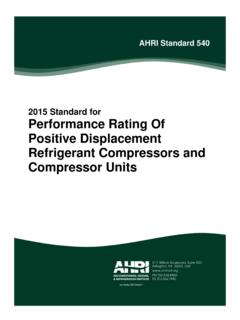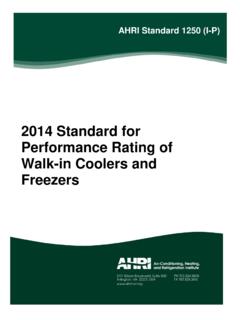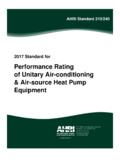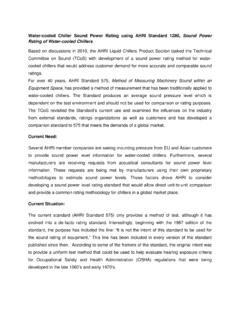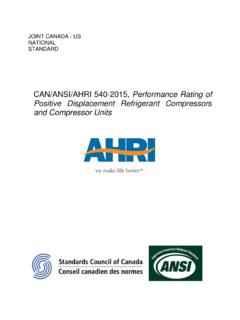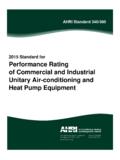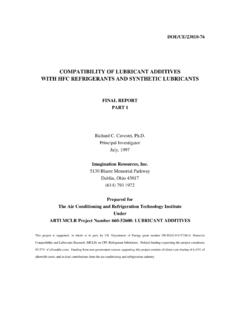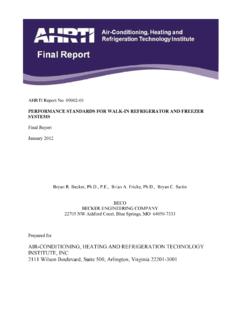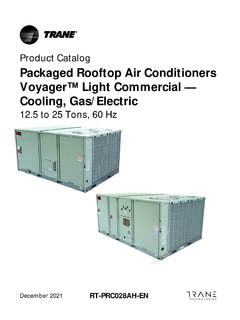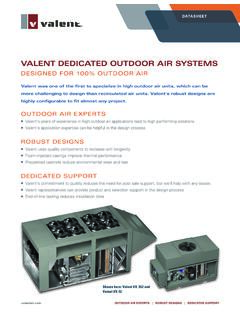Transcription of Performance Rating of Unitary Air-conditioning ... - AHRI
1 Price $ (M) $ (NM) Copyright 2017, by Air-conditioning , Heating, and Refrigeration Institute Printed in Registered United States Patent and Trademark Office 2017 Standard for Performance Rating of Unitary Air-conditioning & Air-source Heat Pump Equipment ahri standard 210/240 Price $ (M) $ (NM) Copyright 2017, by Air-conditioning , Heating, and Refrigeration Institute Printed in Registered United States Patent and Trademark Office Note: This standard supersedes ahri standard 210/240-2008 with Addenda 1 and 2. IMPORTANT SAFETY DISCLAIMER AHRI does not set safety standards and does not certify or guarantee the safety of any products, components or systems designed, tested, rated, installed or operated in accordance with this standard/guideline. It is strongly recommended that products be designed, constructed, assembled, installed and operated in accordance with nationally recognized safety standards and code requirements appropriate for products covered by this standard/guideline.
2 AHRI uses its best efforts to develop standards /guidelines employing state-of-the-art and accepted industry practices. AHRI does not certify or guarantee that any tests conducted under its standards /guidelines will be non-hazardous or free from risk. Price $ (M) $ (NM) Copyright 2017, by Air-conditioning , Heating, and Refrigeration Institute Printed in Registered United States Patent and Trademark Office FOREWORD AHRI issued a call for members (AHRI Update, August 15, 2013) to join the Unitary Small Equipment Engineering Committee Technical Committee (USE EC TC) to revise ahri standard 210/240. Over the course of years and many meetings, the USE EC TC suggested many substantive changes to the standard with three primary intentions. The first intention is to improve the repeatability and accuracy of the psychrometric testing, the second to implement changes addressing technology improvements in both product and laboratories and finally to make the standard more readable and user friendly.
3 Several of these changes were submitted to the Department of Energy (DOE) in the docket for test procedure rulemaking EERE-2009-TP-0004. Several steps are being taken to improve testing, starting with Informative Appendix C is added as a reference for calibration of laboratory sub-systems. This process is currently mandatory for any independent laboratory which conducts tests for the AHRI USAC or USHP Certification Programs. The intention is to make this process normative with the next revision of ahri standard 210/240. Further, normative Appendix D is added for improvement in consistency of refrigerant enthalpy and outdoor air enthalpy secondary capacity checks. Additions and modifications of ASHRAE Standard 37 and ASHRAE Standard 116 Methods of Test (MOT) are provided in normative Appendices E and F.
4 These changes add clarification and specification where both independent and manufacturer testing laboratories have found needed revisions and are a holding spot until the current ASHRAE SPC 37 Committee can complete its work to revise and combine those MOTs. It is expected these two appendices will be removed in the next revision cycle after the next update of ASHRAE Standard 37 (with ASHRAE Standard 116 rolled in), which is expected in 2018. As product and testing laboratory technology has advanced, the USE EC TC found the need to provide clarification on several issues addressing new technology such as variable speed compressors, variable speed air moving systems, laboratory measurement processes, etc. Further, some changes in this 2017 version of the standard are intended to be more representative of product as it operates today.
5 This 2017 version is modified to implement modifications, including those mentioned above, that have been adopted by the Department of Energy (DOE) in their final rules for test procedures, published June 2016 (81 FR 36991), August 2016 (81 FR 55111) and January 2017 (82 FR 1426). The user of ahri standard 210/240 is cautioned that the DOE has not removed the following change, removed from this version of ahri standard 210/240: 1. Three test variations were removed as there were no known products being manufactured. One variation was for triple split air-conditioners or heat pumps, the other was for single speed product having variable airflow rates based on outdoor ambient, and constant RPM indoor fans. As the standard grew to address new technologies over the years (primarily two-stage and variable-stage systems), for many users the standard had become cumbersome and confusing.
6 As an example, the same test conditions (95 F outdoor dry bulb, 80 F indoor dry bulb and 67 F indoor wet bulb) existed for multiple types of systems, but was known by different names and acronyms depending upon the system type. The USE EC TC combined test condition specifications from 11 different tables with differing names/symbols into 3 simplified tables with common names/symbols. The committee also chose to put all the necessary formulas for calculation of efficiency points into a common section of this standard (using the new harmonized symbols/nomenclature) so the user would not need to flip between multiple standards . Price $ (M) $ (NM) Copyright 2017, by Air-conditioning , Heating, and Refrigeration Institute Printed in Registered United States Patent and Trademark Office AHRI CERTIFICATION PROGRAM PROVISIONS Scope of the Certification Program The Certification Program includes all Unitary Air-conditioning and Unitary Air-source Heat Pump equipment rated below 65,000 Btu/h at ahri standard Rating Conditions (Cooling).
7 Certified Ratings The following Certification Program ratings are verified by test: Unitary Air-Conditioners A. Air-cooled 1. ahri standard Rating Cooling Capacity, Btu/h 2. Energy Efficiency Ratio (EERA,Full), Btu/(W h) 3. Seasonal Energy Efficiency Ratio (SEER), Btu/(W h) B. Water-cooled and Evaporatively-cooled 1. ahri standard Rating Cooling Capacity, Btu/h 2. Energy Efficiency Ratio (EER), Btu/(W h) 3. Integrated Energy Efficiency Ratio(IEER), Btu/(W h) Unitary Air-source Heat Pumps Air-cooled 1. ahri standard Rating Cooling Capacity, Btu/h 2. Energy Efficiency Ratio (EERA,Full), Btu/(W h) 3. Seasonal Energy Efficiency Ratio (SEER), Btu/(W h) 4. High Temperature Heating Standard Rating Capacity, Btu/h 5. Region IV Heating Seasonal Performance Factor, HSPF, using minimum Design Heating Requirement, Btu/(W h) Conformance to the requirements of the Maximum Operating Conditions Test, Voltage Tolerance Test, Low-Temperature Operation Test (Cooling), Insulation Effectiveness Test (Cooling), and Condensate Disposal Test (Cooling), as outlined in Section 8, are also verified by test.
8 Refer to the USAC/USHP Certification Program Operation Manual for more information regarding the AHRI Certification Program. TABLE OF CONTENTS SECTION PAGE Section 1. Purpose .. 1 Section 2. Scope .. 1 Section 3. Definitions and Acronyms .. 1 Section 4. Classifications .. 9 Section 5. Test Requirements .. 12 Section 6. Rating Requirements .. 16 Section 7. Minimum Data Requirements for Published Ratings .. 39 Section 8. Operating Requirements .. 40 Section 9. Marking and Nameplate Data .. 42 Section 10. Conformance Conditions .. 42 Section 11. 43 Section 12. Symbols and Subscripts .. 71 TABLES Table 1. Classification of Unitary Air-conditioners .. 10 Table 2. Classification of Unitary Air-source Heat Pumps .. 11 Table 3. Classification of Multi-split Systems .. 12 Table 4. Refrigerant Line Length Correction Factors.
9 13 Table 5. Test Condition Tolerance for Charging Hierarchy .. 14 Table 6. Informative Guidance for Using ahri standard 210/240 .. 17 Table 7. Required Tests .. 18 Table 8. Test Conditions for Air-cooled Products .. 19 TABLES (Cont d) Table 9. Test Conditions for Water-cooled and Evaporatively-cooled Air-conditioner Products .. 20 Table 10. Values of Standard Capacity Ratings .. 21 Table 11. Minimum External Static Pressure for Ducted Systems Tested with an Indoor AMS Installed .. 24 Table 12. IEER Part Load Rating Conditions .. 30 Table 13. Tolerance on Part Load Percent Load .. 32 Table 14. Application Rating Conditions for I-P standards .. 35 Table 15. t Statistic .. 37 Table 16. Fractional Bin Hours to Be Used in Calculation of SEER .. 50 Table 17. Standardized Design Heating Requirements (Btu/h) .. 57 Table 18.
10 Distribution of Fractional Heating Hours in Temperature Bins, Heating Load Hours, and Outdoor Design Temperature for Different Climatic Regions .. 58 FIGURES Figure 1. Example Revised Part Load Ambient Conditions for Interpolation .. 31 Figure 2. Voltage Tolerance Test Power Interrupt Procedure .. 41 Figure 3. Schematic of a Single-speed System Operation in the Cooling Mode .. 49 Figure 4. Cooling Load Hours (CLHA) for the United States .. 50 Figure 5. Schematic of a Two-speed System Operation in the Cooling Mode .. 51 Figure 6. Schematic of a Variable Speed System Operation in the Cooling Mode .. 54 Figure 7. Heating Load Hours (HLHA) for the United States .. 58 Figure 8. Schematic of a Single-speed Heat Pump Operation .. 61 Figure 9. Schematic of a Two-speed Heat Pump Operation .. 62 Figure 10. Schematic of a Variable Speed Heat Pump Operation.
